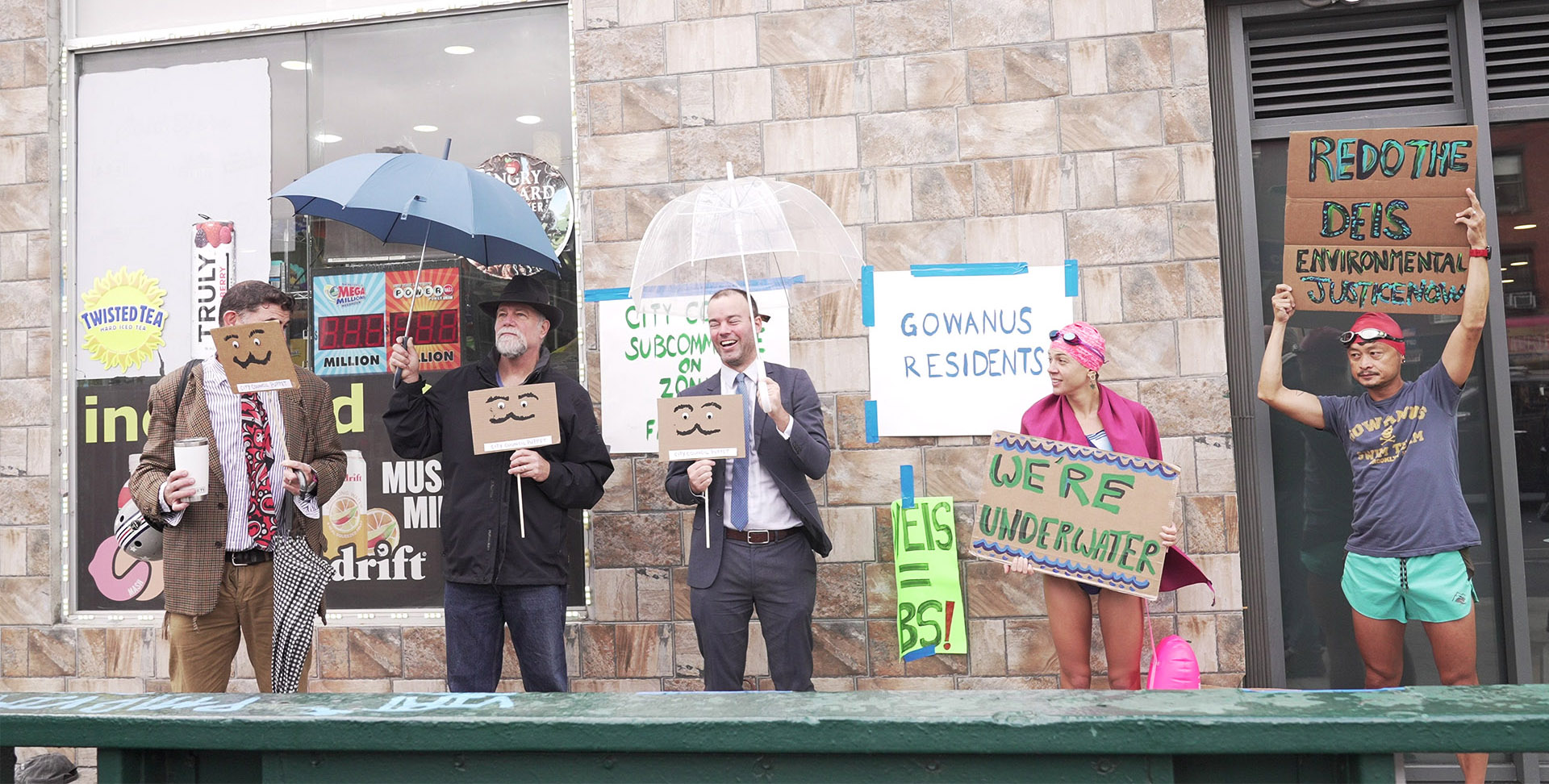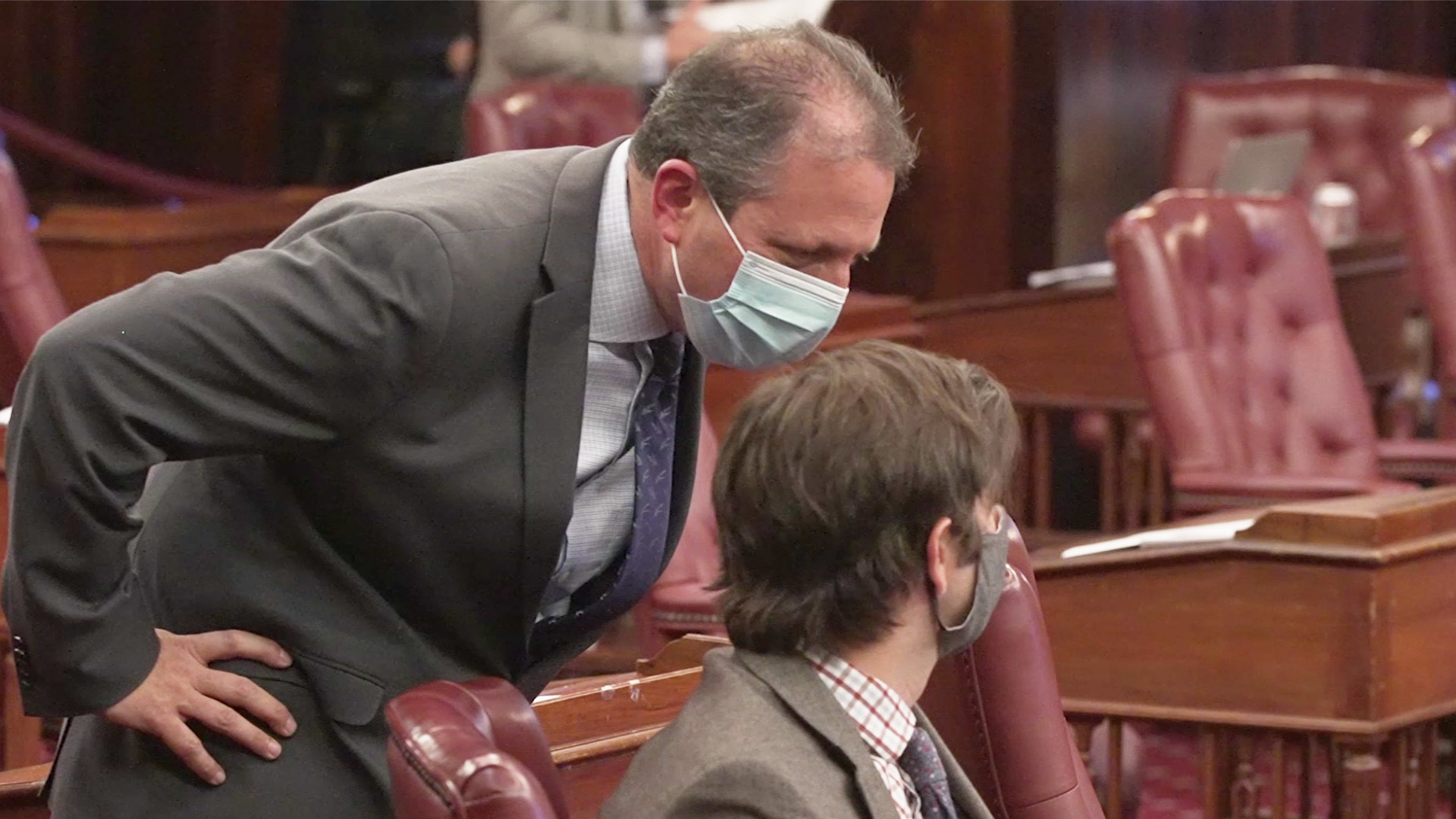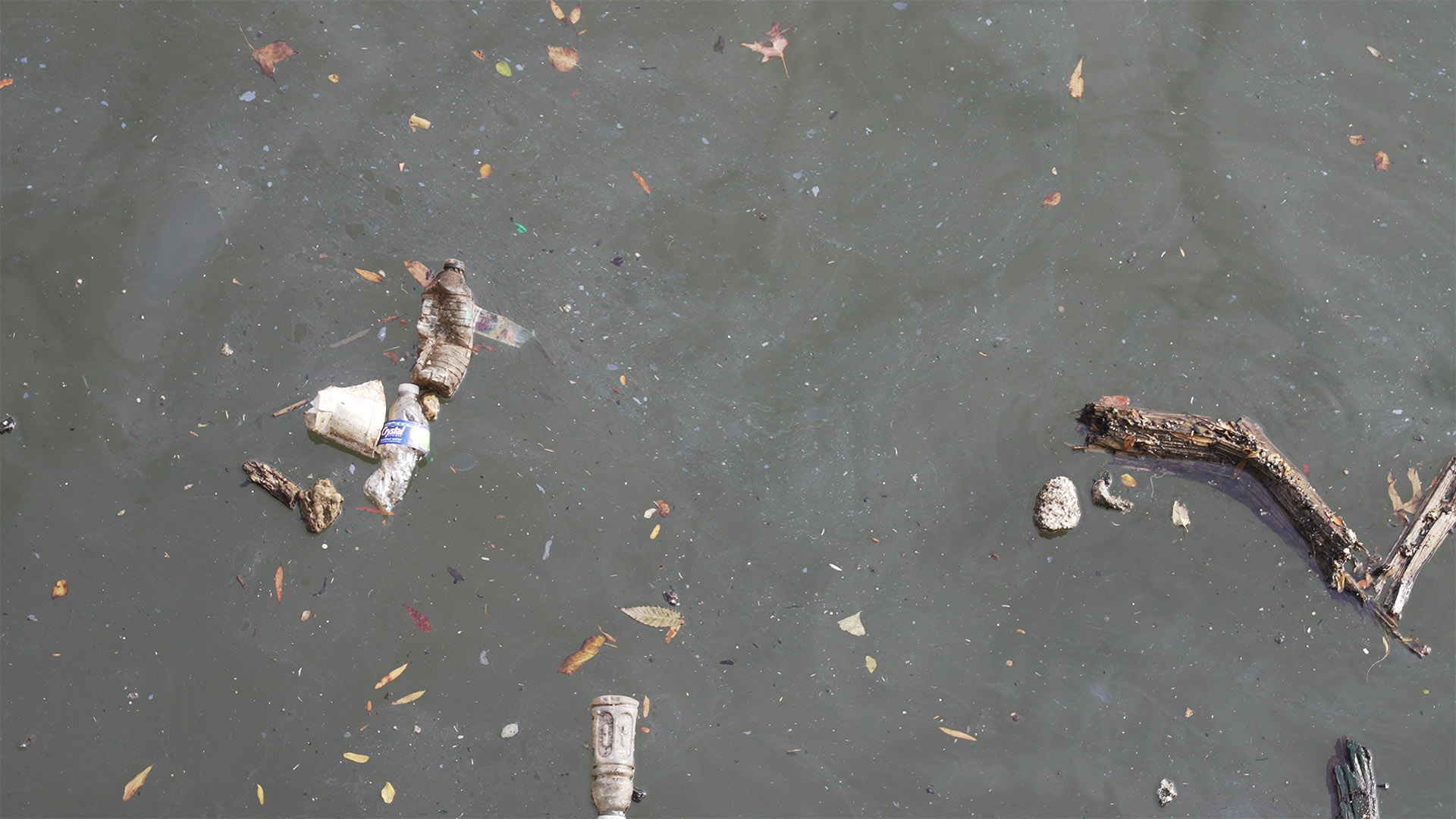Gowanus Rezoning
By Lyuwei Chen
Wearing a bikini, swimming goggles on her head, and a towel on her shoulders, Nora Almeida stood at the entrance of the chilly 4th Avenue subway station in Brooklyn, where there is no beach, only hurrying pedestrians.
Although it was a late autumn morning, there were also a few other people in swimsuits, holding swimming rings and yelling “our houses are flooded and we are swimming in our basements.” Others were wearing suits and holding umbrellas. “Look at the empty land over there, it’s big enough to build more buildings,” they cried out.

Members of Voice of Gowanus protest against the Gowanus Rezoning.
They are residents of Gowanus and they hoped they could stop a massive rezoning proposal in their Brooklyn neighborhood. These activists in particular call themselves Voice of Gowanus, a coalition of neighborhood associations recognized as one of the most outspoken opponents of the 82-block rezoning proposal that would build 8,200 new affordable apartments on top of toxic chemicals that have been in the soil for more than a century. The rezoning would introduce roughly 20,000 new residents to the neighborhood by 2035.
“I am not cold, I am very angry now,” said Almeida, trembling in the wind. Having spent many days dealing with the damage caused by Hurricane Ida, she said she has gained a deeper understanding of how climate change is impacting the lives of locals.

The industrial neighborhood is going to change into a huge residential area.
Historically, Gowanus has suffered from floods and was marked as “Flood Zone A” by the Federal Emergency Management Agency (FEMA). In 2012, when Hurricane Sandy hit Gowanus, the toxic water in the Gowanus Canal, an EPA Superfund site, overflowed and flooded the neighborhood nearby.
In 2021, because of Hurricane Ida and sewage flow problems caused by old infrastructure, Gowanus encountered flooding again. “My basement has been flooded many times since I bought [my house],” said Linda La Violette, the co-chair of Voice of Gowanus.
Despite how controversial the Gowanus Neighborhood Rezoning is, on Nov. 23rd, 2021, the City Council approved the controversial Gowanus Neighborhood Rezoning by a vote of 47-1. Gowanus will transform from an industrial neighborhood into a huge residential area of towers and shopping centers roughly double the size of Hudson Yards, a massive development on Manhattan’s West Side.

Council members Brad Lander and Stephen Levin at City Hall.
“It is an important moment to stop and look at what is broken in our reactive land use process in the era of climate crisis, of affordability crisis, [and] of aging infrastructure. We need a more strategic and more proactive process that grounds future planning in the shared values of New Yorkers,” said Brad Lander, a New York City Council member who championed the Gowanus Neighborhood Rezoning, during the final vote in City Hall.
Lander also mentioned that the de Blasio administration has agreed to invest $174 million to address flooding specifically on 4th Avenue, one of the sites where flooding has occurred in recent years. Projects funded by this money will include rebuilding the 19th street pumping stations and adding new infrastructure along 3rd and 4th Avenues, with the intent of addressing flooding issues in the future.
However, Voice of Gowanus argues that instead of effectively addressing the flood problem in Gowanus, the rezoning plan will create more environmental issues. Most of the new public housing, the Gowanus Green Program for low-income families, will be built on top of the expanding toxic floodplain, the former location of the a Manufactured Gas Plant.

The new public housing, the Gowanus Green, will be built on top of the former location of the a Manufactured Gas Plant.
“We are not going to let them put vulnerable people at risk…we will take the city to court,” said LaViolette. In order to stop the rezoning, Voice of Gowanus has retained attorney Richard J. Lippes, who has argued environmental cases in 20 states — including the well-known Love Canal case.
The battle over the industrial neighborhood’s future and the fate of the Gowanus waterfront is hardly unique. New York City’s 520 miles of waterfront, more than that of Miami, Boston, Los Angeles, and San Francisco combined, has been an industrial and shipping hub for centuries.
New York City has been rezoning its waterfronts since 1993, when it adopted special zoning regulations affecting waterfront development. Intent on maximizing the public’s access to, and enjoyment of, the city’s waterfront resources, this plan also has fulfilled developers’ decades-long desire for high density, mixed-use areas along the shoreline of New York City.
However, global warming causes sea level rise and, consequently, has increased the intensity, frequency, and duration of coastal flooding in New York City. According to the NPCC climate change projections, by the end of the century, New York City may face an increase in mean annual temperature of 4–7.5 Fahrenheit, an increase in the base level rainfall of 5–10%, and a rise in sea level of at least 12–23 inches.

Although the EPA has cleaned up the Gowanus Canal, coal tar, garbages, and leaves can also be seen on the water.
“As sea level rises, coastal flooding will happen in the future with greater frequency and severity because smaller hurricanes will result in tides which are the same height of those created by bigger storms at lower sea levels, as for instance, Hurricane Sandy did in 2012,” said Dr. Klaus H. Jacob, an earthquake, disaster, and climate scientist at Columbia University’s Earth Institute.
Additionally, Jacob mentioned that nor’easters, extra tropical storms that form along the East Coast of North America during winter months, produce heavy snow and blizzards, rain, and coastal storm surges and lead frequently to widespread coastal flooding.
Estimates from the Flood Risk Overview of Gowanus demonstrate that there are 111 properties in Gowanus which, based on the calculation of current density, have a greater than 26% chance of being severely affected by flooding over the next 30 years.
More than 50 artists from Arts Gowanus and Brooklyn Art Cluster suffered the effects of the flooding caused by Hurricane Ida on Sep. 1st, 2021. Sewage water ruined many of their finished pieces of art, works-in-progress, and raw materials. “It was a disaster,” said Johnny Thornton, Executive Director of Arts Gowanus. “Sewage water flowed everywhere. It was so disgusting.”
Jo-Ann Acey, an artist at Arts Gowanus, estimated that she lost $70,000 in finished artwork. “When I saw my framed paintings soaked in the water, I hate to admit, I cried.”
“Most individual artists have no insurance to cover their losses,” said Keun Young Park, the co-founder of Arts Gowanus and the Brooklyn Art Cluster. In hopes of easing Acey’s situation, she published Acey’s story on the crowdfunding website GoFundMe, resulting in $70,000 in donations, which helped Acey get through the difficulties.
On Oct. 3rd, 2021, Brooklyn-based artists facilitated a community Yarn Bomb project on 4th Ave in Gowanus, using art to celebrate the climate resilience of the neighborhood. They named their work “CODE RED!” to highlight the Climate Change Emergency impacting New York City.
In addition to worrying about flooding caused by climate change, community groups on the waterfronts are also fearful of over-gentrification and the resulting displacement of working-class tenants. Rezonings of all kinds, across the city, have faced intense opposition.
The tug-of-war surrounding the transformation of the Gowanus neighborhood is not new, either. “The houses in Gowanus are affordable now. I don’t understand why they want to build more affordable housing which will displace most artists and small businesses in this location,” said Martin Bisi, who runs a music recording studio in the old American Can Factory on 232 3rd Street, a block away from the Gowanus Canal.
Bisi used to hope that he would be able to keep this studio, which he has rented since 1979. However, his dream has been crushed by the reality that a tower will be built on top of his studio. Facing the result of the final vote, he said disappointingly, “I expected it [might pass]. But I didn’t expect it to be 47-1.”

Katia Kelly, member of Voice of Gowanus.
Katia Kelly of Voice of Gowanus lives 2.5 blocks away from the Gowanus Canal. An immigrant from Germany, she and her family have lived in the neighborhood for 36 years. Having tried to remediate the toxic legacy of the Gowanus Canal since 2006, Kelly said that the potential health risks associated with the toxic Gowanus Canal flooding have been bothering her.
“No one [in the government] is hearing our voice,” Kelly said. Now that the Gowanus rezoning is truly about to proceed, in addition to her usual worries, she is also confused. “We don’t understand. The canal is so polluted. Why would you go ahead but not clean it up first?”